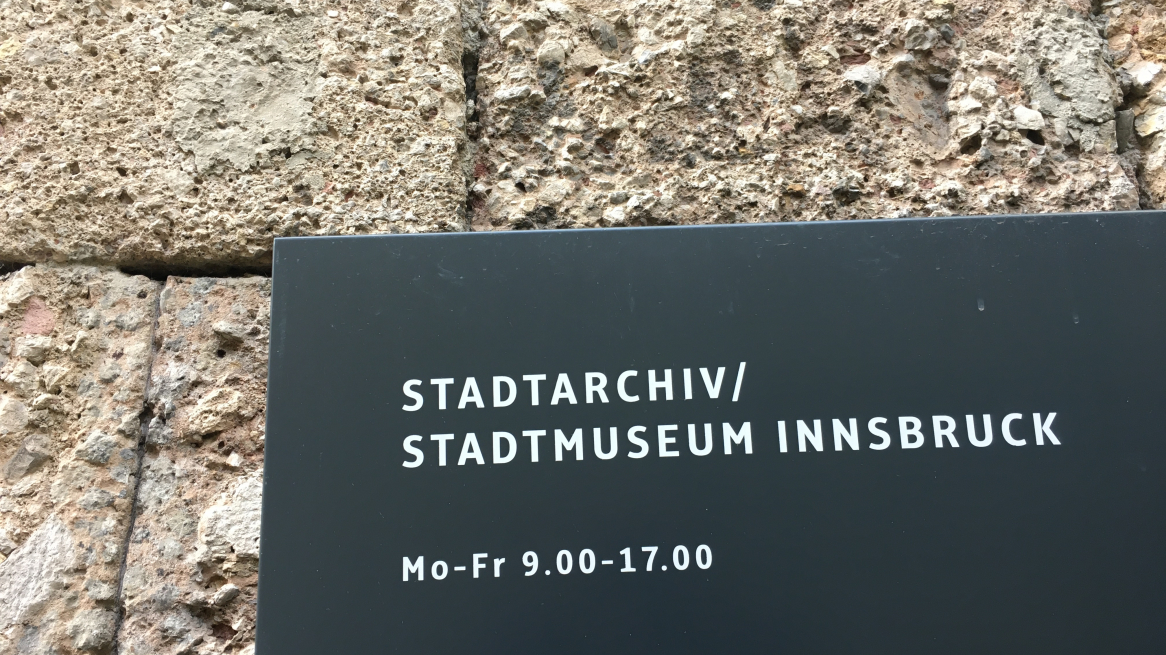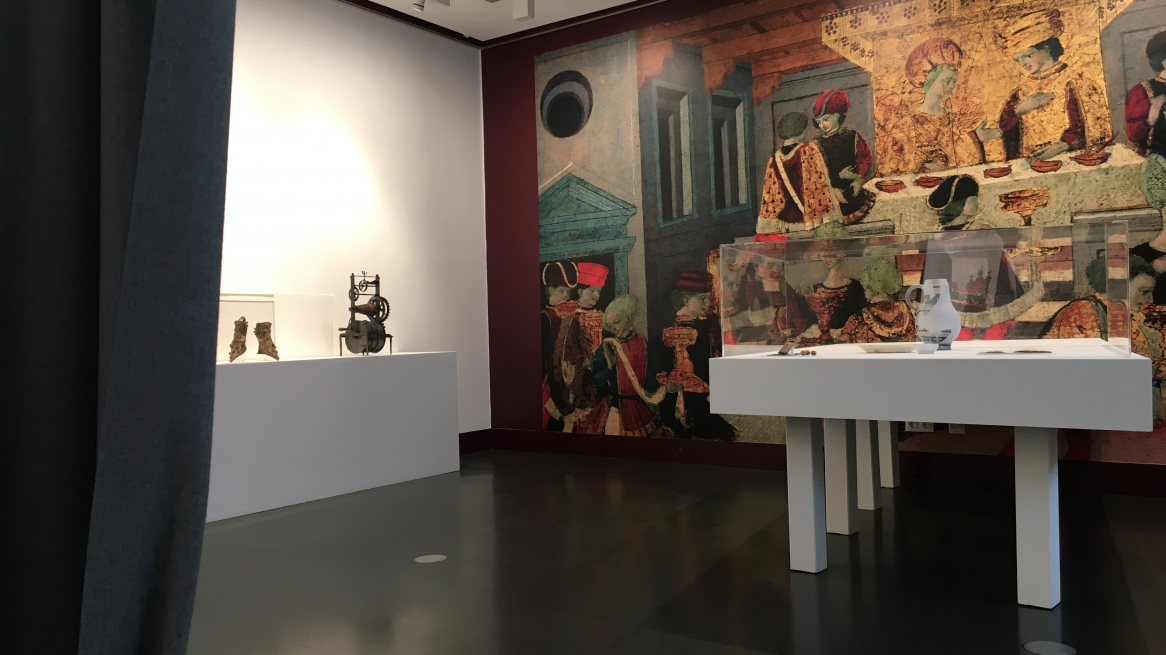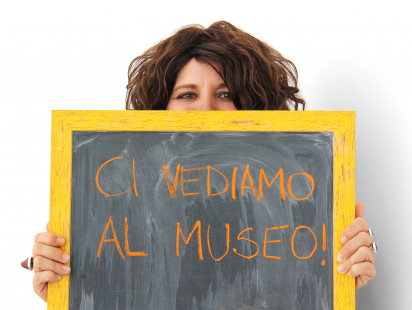
Our destination today is Badgasse, at number 2. We leave behind the Golden Roof and the bustle of people and walk a few meters down Pfarrgasse, in the direction of the Cathedral. The first alley on the left is Badgasse, very impressive for the buildings with massive historic walls and for its quietness. At number 2 we find the Innsbruck City Museum and Archives. We enter.
An exhibition dedicated to the city of Innsbruck, residence of archdukes and emperors
On the ground floor of the building is the Museum. Here the interesting exhibition „Im Aufbruch. Innsbruck wird Residenzstadt“ dedicated to how life in the city has changed since 1420, when Duke Frederick IV of Austria bought two buildings in the city center and moved permanently to Innsbruck, can be visited until April 21, 2023. Since then, the city has become the residence of important personalities-from archdukes to emperors-who have stayed there and shaped the economy and life of the Tyrolean capital. On display are books, objects, official records, and maps, which tell of these changes in the city of Innsbruck.
The close connection between museum and archives is one of the strengths of this institution. For the current exhibition, for example, a lot of material comes from the archive-which is located in the same building-but there are also loans from other institutions.
A glimpse of the „Im Aufbruch. Innsbruck wird Residenzstadt“ exhibition at the Innsbruck City Museum, Photo © Laura Manfredi
Archive collects to tell the story of people's lives
But what are the tasks of Innsbruck's City Museum and City Archives? Lukas Morscher, historian and writer, who in 2023-to be exact on September 14-celebrates his 25 years of service as head of these two institutions, explained it to us.
"A city archive normally takes over from the municipality the documents that are no longer used in daily management. From the Department of Sports to the Department of Commerce or the Department of Social Policy, to give an example. These records are preserved, sorted and, after a certain period of time, made available to researchers and historians.
This is just one of our tasks. We try to document everything that can tell the story of people's lives in Innsbruck. In fact we also collect photographs, posters and playbills, menus, drawings, diaries, newspapers, letters, historical objects and much more."
Accounts for the renovation of the Innsbruck Hofburg (1567, Tiroler Landesarchiv) that took place under Ferdinand II, in the exhibition „Im Aufbruch. Innsbruck wird Residenzstadt“ at the Innsbruck City Museum, Photo © Laura Manfredi
Always exciting work
You have been directing these two institutions-the archives and the museum-for 25 years. What for you is the most interesting and fascinating part of your work?
"Twenty-five years ago I was fortunate that the then mayor Van Staa decided to entrust the city archives to a young man, who did not yet have a name. It was not always easy and every now and then something even went wrong ... You have to get over it. But overall I think the balance is positive.
There was not a day when I came home from work without having learned something new: professionally, humanly or in other respects. And that is good. It is even more so now that I am "old"[ed. Lukas Morscher writes like that, but he is only 54], because when you have a lot of experience and have lived through (almost) everything, you no longer have to prove anything to anyone.
Work is a team game. Alone you can do little. In a team a lot. If a team works well, then yes you make great strides: new ideas, new projects, but also the performance of ordinary work. It simply feels good, and I don't think I've ever had as much fun as I do working now."
View of Innsbruck by Georg Hoefnagl (1575, Stadtarchiv Innsbruck), in the exhibition „Im Aufbruch. Innsbruck wird Residenzstadt“ at the Innsbruck City Museum, Photo © Laura Manfredi
Innsbruck remembers ..
Is there an archive and museum project that is particularly close to your heart?
"One of the most important projects-almost like a son-is the „Innsbruck erinnert sich“ . At the outbreak of the Covid 19 pandemic, our own Niko Hofinger had the idea to at least make virtual walks during the quarantine possible. Since then 4 new contents are published on this site every day. This takes a lot of work, but about 300,000 hits per month and hundreds of reader comments repay the effort."
The website www.innsbruck-erinnert.at publishes four new pieces of content - photos or various documents - from the city's archives every day, Photo © Laura Manfredi
The site shows historical photos of the city from the civic archives. What I find very interesting is the setting. This is not a nostalgic operation, but a way to share stories and gather information from the community. Images are posted under different headings. One of them could be translated as "rebuses" („Rätsel“ in German): here are pictures about which you have little information and you ask readers to share theirs. Thus many of these rebuses are actually solved. In addition, this very rich database of images, documents and illustrations is divided by themes - such as City Life, Work and Everyday Life, People, Buildings ... - and it is also possible to search by keywords. For those with a penchant for history, it is delightful to get lost in it ..
Lukas Morscher told me about many other projects, which are enough to write another article.
Who will these guys be? You can find their story at „Innsbruck erinnert sich“ (https://innsbruck-erinnert.at/urlaub-einmal-ganz-anders/ )
What plans do you have for the future?
"Well, I have a lot of projects. Many more than I have time for, in my personal life and in my work life. There are some book ideas, for which I will never have the time. Several digitization projects, some topics to which I would like to devote exhibitions, and much more. But you have to be realistic: you cannot do everything.
Realistic goals are to close projects that are already under way and to carefully prepare the handover to those who will take over my position after me. However, I do not know how long this will take. At the moment, however, there is still much to be done, and I am happy about that.
Also, a privilege of the age is to be invited to serve on juries and commissions. This gives me the opportunity - hopefully - to contribute to changes. Moreover, it allows me to compare myself with other experts, something from which one always learns a lot."
The bustle in front of the Golden Roof in a 1765 painting by Michael SH (Stadtarchiv Innsbruck), in the exhibition „Im Aufbruch. Innsbruck wird Residenzstadt“ at the Innsbruck City Museum, Photo © Laura Manfredi
Useful information
Exhibition „Im Aufbruch. Innsbruck wird Residenzstadt“
until April 21, 2023
Stadtarchiv/Stadtmuseum Innsbruck
Badgasse 2, Innsbruck
Exhibition texts are in German and English.
Hours:
Monday through Friday, 9 a.m. to 5 p.m
Tickets:
Full 4 euros, reduced 2.80 euros, free up to 6 years of age and with the Innsbruck Card.
Combined tickets are available to visit in addition to the Municipal Museum, the Golden Roof and the Civic Tower.
Access for the disabled:
Herzog-Friedrich-Straße 3, Innsbruck
Rate this article
Show me the location on the map
A visual artist from Milan who not only works with brushes and canvases but also loves writing about art, culture, music, design and creativity.
Similar articles
Innsbruck is a popular tourist destination. The big attraction remains the mountains, but the city has a…
Not just looking at art, but getting to know it better on a guided tour, talking about…
The 'Path of the Senses' from Rietz via Stams to Mötz-Locherboden is an exploration in the…
The museum in Innsbruck's Arsenal "Museum im Zeughaus" was reopened on April 6,…












